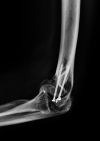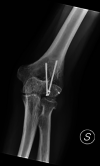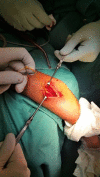The stiff elbow: Current concepts
- PMID: 32913596
- PMCID: PMC7459370
- DOI: 10.4081/or.2020.8661
The stiff elbow: Current concepts
Abstract
Elbow stiffness is defined as any loss of movement that is greater than 30° in extension and less than 120° in flexion. Causes of elbow stiffness can be classified as traumatic or atraumatic and as congenital or acquired. Any alteration affecting the stability elements of the elbow can lead to a reduction in the arc of movement. The classification is based on the specific structures involved (Kay's classification), anatomical location (Morrey's classification), or on the degree of severity of rigidity (Vidal's classification). Diagnosis is the result of a combination of medical history, physical examination (evaluating both active and passive movements), and imaging. The loss of soft tissue elasticity could be the result of bleeding, edema, granulation tissue formation, and fibrosis. Preventive measures include immobilization in extension, use of post-surgical drain, elastic compression bandage and continuous passive motion. Conservative treatment is used when elbow stiffness has been present for less than six months and consists of the use of serial casts, static or dynamic splints, CPM, physical therapy, manipulations and functional re-education. If conservative treatment fails or is not indicated, surgery is performed. Extrinsic rigidity cases are usually managed with an open or arthroscopic release, while those that are due to intrinsic causes can be managed with arthroplasties. The elbow is a joint that is particularly prone to developing stiffness due to its anatomical and biomechanical complexity, therefore the treatment of this pathology represents a challenge for the physiotherapist and the surgeon alike.
Keywords: Stiff elbow; elbow; elbow contracture; post-traumatic stiffness.
©Copyright: the Author(s).
Conflict of interest statement
Conflict of interest: The authors declare no potential conflict of interest.
Figures





References
-
- Bedeschi Celli. Il gomito. Patologia traumatica. 1990th ed. Aulo Gaggi.
-
- Hildebrand KA. Posttraumatic elbow joint contractures: defining pathologic capsular mechanisms and potential future treatment paradigms. J Hand Surg 2013;38:2227-33. - PubMed
-
- Kodde IF, van Rijn J, van den Bekerom MPJ, Eygendaal D. Surgical treatment of post-traumatic elbow stiffness: a systematic review. J Shoulder Elbow Surg 2013;22:574-80. - PubMed
LinkOut - more resources
Full Text Sources
Medical

